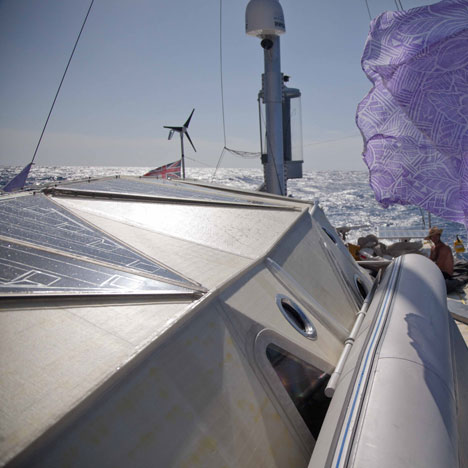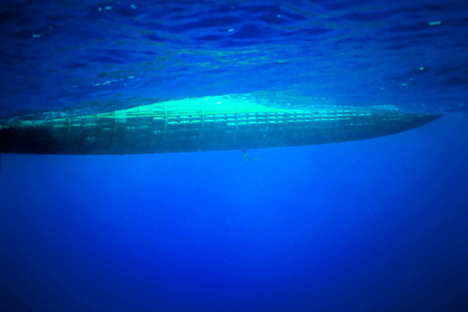
A boat made of plastic bottles designed by Exploration Architecture is nearing the end of its journey across the Pacific Ocean from San Francisco to Sydney to highlight pollution of the seas.

The hull of the boat, called Plastiki, comprises whole plastic bottles filled with pressurised air.

These bundles of bottles are wrapped in a shell of fibreglass-like material, itself made entirely from recycled plastic bottles.

Commissioned by David de Rothschild of Adventure Ecology, the vessel is designed to be recyclable at the end of its journey, produce all its own energy and create no pollution.

12,500 bottles were used to make the hull – about the same number consumed in the USA every 8.3 seconds.

The Plastiki Expedition is due to arrive in Sydney next week. Loads more information on the expedition website.

More green stories on Dezeen »
More transport stories on Dezeen »

Here’s some more information from Exploration Architecture:
Design Concepts for the Plastiki
The Plastiki expedition boat, made entirely from plastic bottles, is due to arrive in Sydney within the next week after crossing the Pacific and having drawn attention to the shocking state of the world’s oceans.

The boat sailed through the ominously named Pacific Garbage Patches – two vast areas of floating pollution which represent a powerful metaphor for the way we treat the oceans. We behave as if the sea has a limitless capacity to absorb our pollution and as long as it is out of sight we’re not bothered.

They are also a clear example of what is wrong with our current paradigm which involves using resources in a linear, wasteful and polluting way. Much of the pollution that exists in the garbage patches is plastic waste which gradually breaks down into short lengths of polymer which absorb other pollutants and accelerate their uptake into the marine food-chain.

The project was the brainchild of explorer and founder of Adventure Ecology, David de Rothschild. Exploration Architecture worked with David on the concept design and helped to shape some of the key ideas. We shared many of the client’s interests in the closely related fields of biomimicry and Cradle to Cradle design.

The brief for the Plastiki project was to design a boat that could be sailed across the pacific on an expedition that would not just highlight the problems facing the oceans but also showcase the kind of solutions that we need to implement.

We agreed that, to set the right example, the boat should be designed to be fully recyclable at the end of the journey, generate all its own energy and emit no pollution. We also felt that the bottles should be used intact rather than simply melted down into a sheet material and turned into a conventional boat.

The first challenge was to find a way to turn a very weak material (plastic bottles) into a structure that would withstand the forces likely to be experienced on a voyage through the Pacific Ocean. We took our inspiration from a number of sources but the one that provided the greatest break-through was a pomegranate.

We realized that each individual segment had a degree of internal pressure which, combined with close geometric packing and a tough skin produces a very resilient form. This led to the idea of pressurizing each bottle with air – a simple move that transformed the bottles into incredibly solid objects.

In our tests we proved that just by adding air pressure it was possible for two plastic bottles to support the weight of a car. The first sketches were based on the idea of forming bundles of tightly packed bottles with some framing members and a tough skin on the outside. This subsequently developed into a scheme that created a core of sheet material (made from recycled plastic bottles) into which the bottles would be packed to provide stiffness as well as buoyancy.

This was the scheme that was taken forward to construction by the naval architect Andy Dovell. The team later found a supplier of a revolutionary sheet material called SrPET that uses recycled plastic bottles in two forms – one like a fiber and one like a resin – so that when put together they create a material that is very similar to fiberglass.

However, unlike fiberglass which is impossible to recycle, the SrPET is made entirely from one material and can be recycled indefinitely with no loss of resources or material quality – the holy grail of Cradle to Cradle design. The design of the systems on the boat presented other challenges as we were determined that the Plastiki should be a zero emissions boat.
Click above for larger image
Generally zero waste technologies are easier to achieve at large scale so if we could demonstrate that this was possible on a small scale, it would send a powerful message to the larger ships which currently treat the ocean as a vast sewer. For the energy, we explored a range of renewable technologies including wind turbines, sea turbines, photovoltaic panels and even a new form of anaerobic digester that could generate hydrogen from human waste.
Click above for larger image
Providing fresh water for the crew led us to develop a custom-made desalination system inspired by the Namibian fog-basking beetle that has evolved to harvest its own water in a desert. It was very satisfying to see the concepts of biomimicry being taken through the whole project including the first use of a biomimetic and completely non-toxic glue as an alternative to the conventional resin-based compounds used in boat building.
Click above for larger image
Ideas for the project legacy continue to evolve but the way the boat has been designed it makes it possible for the whole thing to be recycled without pollution or waste: the bottles can be up-cycled into fleeces, the SrPET could be turned into another boat or back into bottles, the systems can be redeployed and the sailing equipment re-used.
Click above for larger image
David’s determination for the project to be about solutions rather than just highlighting problems has resulted in a range of closed loop design examples. This shows that, with the right attitude, it is possible to design out waste and to rethink the way we use resources to create far more intelligent solutions.
Click above for larger image
There are two profound shifts we need to make: from a linear to a closed loop use of resources and from a fossil fuel economy to a solar economy. Biomimicry will continue to provide many of the solutions that we need and with projects like the Plastiki Expedition we can bring about positive change.
Client: Adventure Ecology
Concept architect: Exploration Architecture
Structural Engineer: Atelier One
M&E Consultant: Atelier Ten
Materials consultant: Arup
Naval Architect: Andy Dovell
Boat builder: Andy Foxtec









所有评论